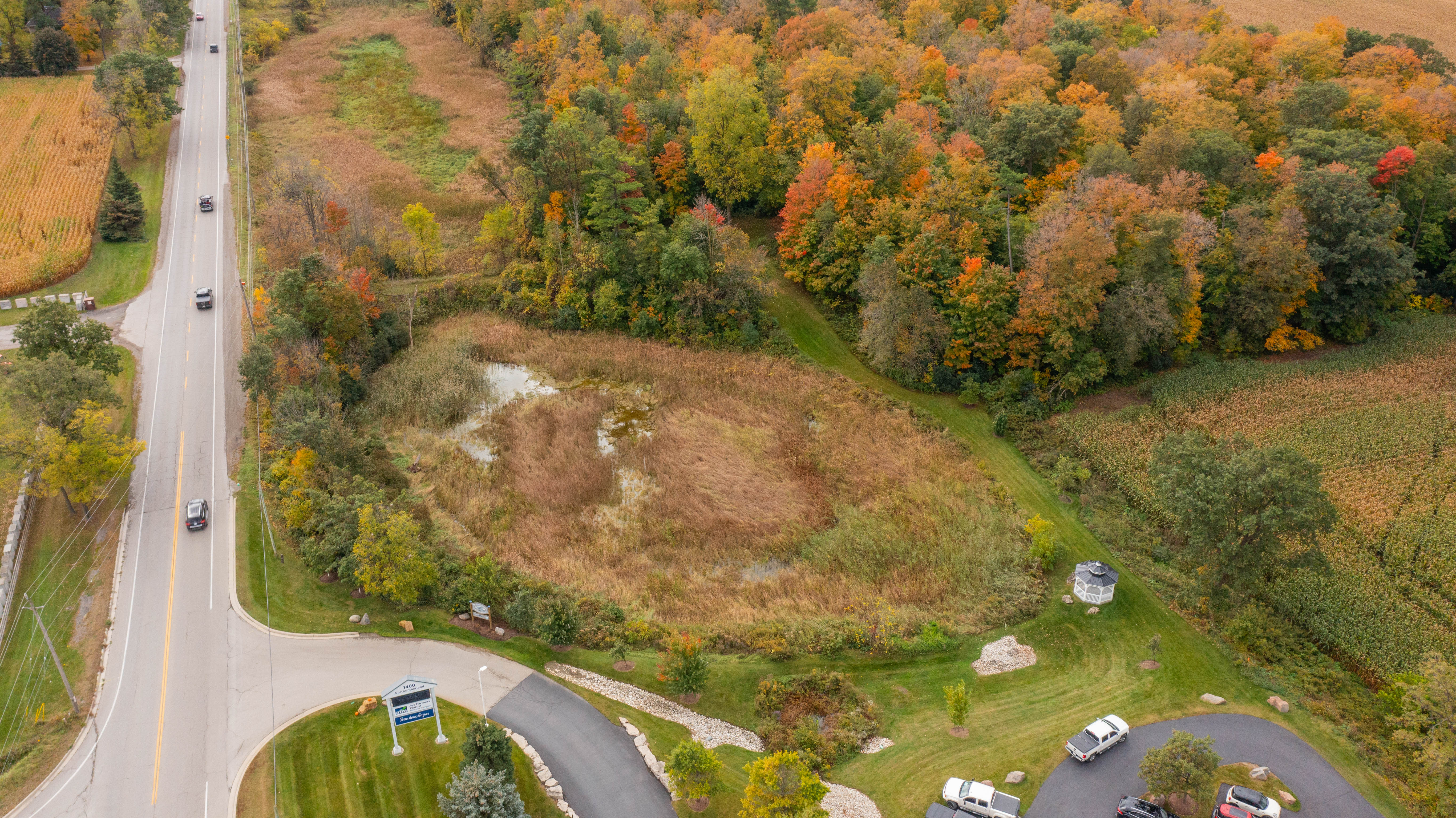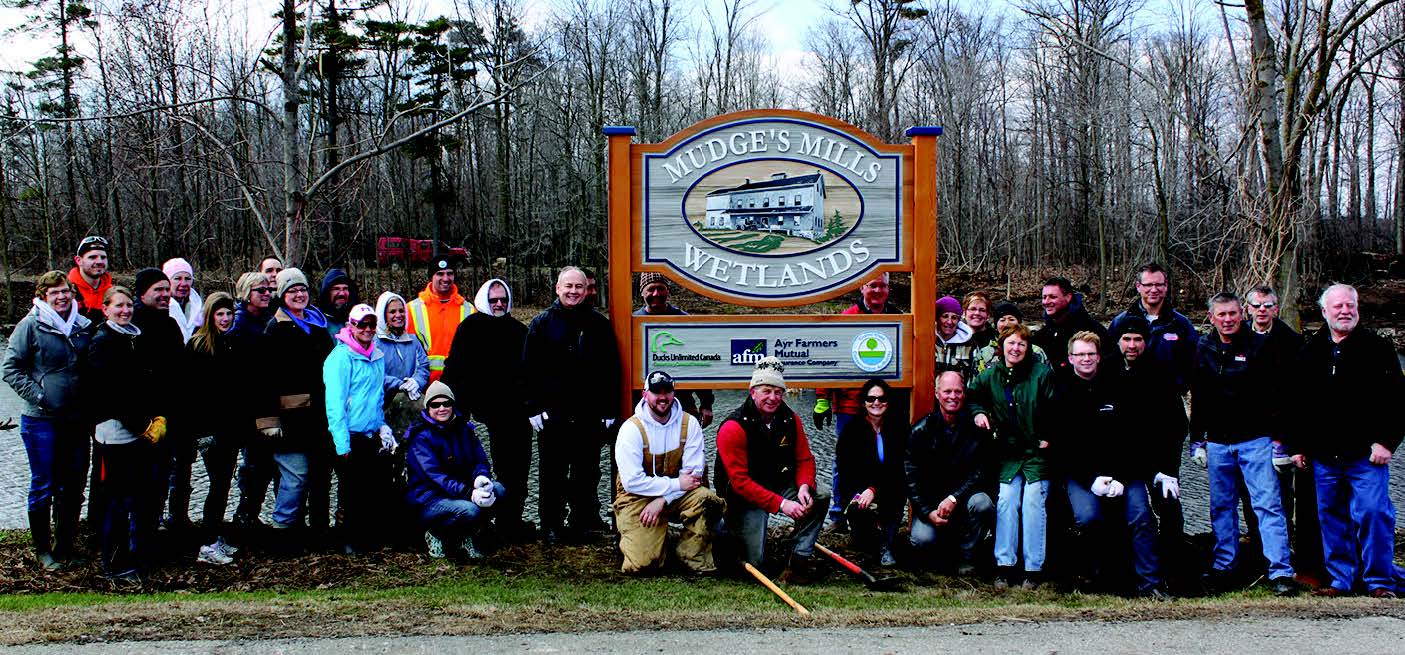

In 2014, together with Ducks Unlimited and the Grand River Conservation Authority, Ayr Farmers Mutual rehabilitated a former, inefficient wetland on our property into a re-established, functional, and improved wetland area. Wetlands are dynamic, productive, and diverse ecosystems. They are wildlife nurseries and nesting sites, feeding grounds and resting places, water filters and reservoirs. In April of 2014, AFM employees planted over 40 native trees, shrubs, wildflowers and grasses around the wetlands area, which was named Mudge’s Mills Wetlands.
Within our office, we had a contest to name the wetlands. “Mudge’s Mills Wetlands” was selected as the winning name, in honour of Abel Mudge – one of the first citizens to arrive in Ayr back in 1824, when the village of Ayr was comprised of Jedburgh, Nithvale and an area where the waters of the Nith River and Cedar Creek meet. Abel Mudge came up the Nith River from Canning (just outside Paris) in the early 1800s and built a mill at the confluence of Cedar Creek and the Nith River and was instrumental in creating Northumberland Street (the street AFM is located on today). Abel Mudge built a sawmill and grist mill at the confluence joining of the waterways and the area became known as Mudge’s Mills.
Wetlands of Ontario
Not land or water, but a fluid combination of both, wetlands are among the most productive habitats on Earth. Wetlands are all built on a simple foundation: water becomes trapped, either through poor drainage, periodic flooding or by coastal barriers such as sandbars, and a wetland – that unique mix of land and water – is born.
From this beginning, wetlands develop in a number of ways depending on local climate conditions, the availability of nutrients, and the geography and soils of a site. They also change over time: an open marsh may dry out enough to become a wooded swamp, only to revert back to open marsh again after heavy flooding.
In the past, wetlands were thought of as mosquito-infested wastelands that could only be dealt with by draining, filling or paving. Now, wetlands are increasingly recognized as much more dynamic, productive and diverse ecosystems. They are wildlife nurseries and nesting sites, feeding grounds and resting places, water filters and reservoirs. They help protect shoreline areas from storm damage, control and reduce flooding, clean sediment-laden waters, and attract fish, birds, amphibians, reptiles and mammals. They are also great places for people to explore and reconnect with nature.
Yet, despite these values, wetlands continue to be lost at an alarming rate. They are drained for agriculture, filled for development, polluted by toxic runoff, invaded by exotic species, and damaged by artificial changes in water levels. If we continue to lose wetlands, a large and important piece of the natural system that keeps our world healthy will disappear. (Taken from website of Environment Canada)


A History of Mudge's Mills
Ayr was originally the three closely adjoined villages of Mudge's Mills, Jedburgh, and Nithvale. The first settler to arrive in the area was Abel Mudge. Before landing in the area, Abel resided near Paris in a place known as Mudge Hollow (now Canning) which was settled by members of his family during the late eighteenth or early nineteenth century.
Abel constructed a dam and built both a sawmill and a grist mill at the confluence of Smith's Creek (now the Nith River) and Cedar Creek. This site subsequently became known as Mudge's Mills. In 1826, Mudge petitioned officials of Halton County in the District of Gore to have a road built north from Mudge's Mills to Roseville. The road that was consequently built between the two villages was called Northumberland Street, and was declared a public road. Consequently, Mudge's Mills attained greater accessibility which no doubt attracted settlement and development.
Most of these settlers were farmers but a significant number were artisans and tradespersons. In 1839, Mudge's Mills was formally laid out for settlement. An increase in settlement brought about the need for the establishment of a post office which the three villages received in 1840. It was located at Mudge's Mills. The post office was given the name Ayr, by which name Mudge's Mills thereafter became known.
